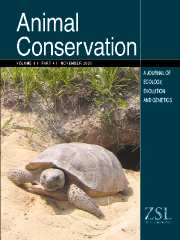Crossref Citations
This article has been cited by the following publications. This list is generated based on data provided by
Crossref.
Jepsen, J U
and
Topping, C J
2004.
Modelling roe deer (Capreolus capreolus) in a gradient of forest fragmentation: behavioural plasticity and choice of cover.
Canadian Journal of Zoology,
Vol. 82,
Issue. 9,
p.
1528.
Ogutu, Joseph O.
Bhola, Nina
and
Reid, Robin
2005.
The effects of pastoralism and protection on the density and distribution of carnivores and their prey in the Mara ecosystem of Kenya.
Journal of Zoology,
Vol. 265,
Issue. 3,
p.
281.
Boydston, Erin E.
Kapheim, Karen M.
and
Holekamp, Kay E.
2006.
Patterns of den occupation by the spotted hyaena (Crocuta crocuta).
African Journal of Ecology,
Vol. 44,
Issue. 1,
p.
77.
Iverson, John B.
Converse, Sarah J.
Smith, Geoffrey R.
and
Valiulis, Jennifer M.
2006.
Long-term trends in the demography of the Allen Cays Rock Iguana (Cyclura cychlura inornata): Human disturbance and density-dependent effects.
Biological Conservation,
Vol. 132,
Issue. 3,
p.
300.
Young, J.K.
Andelt, W.F.
Terletzky, P.A.
and
Shivik, J.A.
2006.
A comparison of coyote ecology after 25 years: 1978 versus 2003 This is Welder Wildlife Foundation contribution No. 651..
Canadian Journal of Zoology,
Vol. 84,
Issue. 4,
p.
573.
Kolowski, Joseph M.
Katan, Dijana
Theis, Kevin R.
and
Holekamp, Kay E.
2007.
Daily Patterns of Activity in the Spotted Hyena.
Journal of Mammalogy,
Vol. 88,
Issue. 4,
p.
1017.
Pokines, James T.
and
Kerbis Peterhans, Julian C.
2007.
Spotted hyena (Crocuta crocuta) den use and taphonomy in the Masai Mara National Reserve, Kenya.
Journal of Archaeological Science,
Vol. 34,
Issue. 11,
p.
1914.
Holmern, Tomas
Nyahongo, Julius
and
Røskaft, Eivin
2007.
Livestock loss caused by predators outside the Serengeti National Park, Tanzania.
Biological Conservation,
Vol. 135,
Issue. 4,
p.
518.
Watts, H. E.
and
Holekamp, K. E.
2008.
Interspecific competition influences reproduction in spotted hyenas.
Journal of Zoology,
Vol. 276,
Issue. 4,
p.
402.
Kissui, B. M.
2008.
Livestock predation by lions, leopards, spotted hyenas, and their vulnerability to retaliatory killing in the Maasai steppe, Tanzania.
Animal Conservation,
Vol. 11,
Issue. 5,
p.
422.
Kolowski, J. M.
and
Holekamp, K. E.
2009.
Ecological and anthropogenic influences on space use by spotted hyaenas.
Journal of Zoology,
Vol. 277,
Issue. 1,
p.
23.
Van Meter, Page E.
French, Jeffrey A.
Dloniak, Stephanie M.
Watts, Heather E.
Kolowski, Joseph M.
and
Holekamp, Kay E.
2009.
Fecal glucocorticoids reflect socio-ecological and anthropogenic stressors in the lives of wild spotted hyenas.
Hormones and Behavior,
Vol. 55,
Issue. 2,
p.
329.
Graf, Jan A.
Somers, Michael J.
Gunther, Micaela Szykman
and
Slotow, Rob
2009.
Heterogeneity in the density of spotted hyaenas in Hluhluwe-iMfolozi Park, South Africa.
Acta Theriologica,
Vol. 54,
Issue. 4,
p.
333.
Ogutu, J. O.
Piepho, H.‐P.
Dublin, H. T.
Bhola, N.
and
Reid, R. S.
2009.
Dynamics of Mara–Serengeti ungulates in relation to land use changes.
Journal of Zoology,
Vol. 278,
Issue. 1,
p.
1.
Watts, Heather E.
and
Holekamp, Kay E.
2009.
Ecological Determinants of Survival and Reproduction in the Spotted Hyena.
Journal of Mammalogy,
Vol. 90,
Issue. 2,
p.
461.
Holcomb, K.
Young, J. K.
and
Gerber, L. R.
2009.
The influence of human disturbance on California sea lions during the breeding season.
Animal Conservation,
Vol. 12,
Issue. 6,
p.
592.
Holekamp, Kay E.
and
Dloniak, Stephanie M.
2010.
Behavioral ecology of tropical animals.
Vol. 42,
Issue. ,
p.
189.
Davis, M. L.
Kelly, M. J.
and
Stauffer, D. F.
2011.
Carnivore co-existence and habitat use in the Mountain Pine Ridge Forest Reserve, Belize.
Animal Conservation,
Vol. 14,
Issue. 1,
p.
56.
Mogensen, Niels L.
Ogutu, Joseph. O.
and
Dabelsteen, Torben
2011.
The effects of pastoralism and protection on lion behaviour, demography and space use in the Mara Region of Kenya.
African Zoology,
Vol. 46,
Issue. 1,
p.
78.
Ordiz, Andrés
Støen, Ole-Gunnar
Delibes, Miguel
and
Swenson, Jon E.
2011.
Predators or prey? Spatio-temporal discrimination of human-derived risk by brown bears.
Oecologia,
Vol. 166,
Issue. 1,
p.
59.


